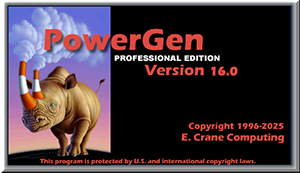POWERGEN OVERVIEW

PowerGen is the essential tool to automate the building of PowerBuilder® applications. It lets you use command line functions to automate the entire build, create libraries from object source. With PowerGen, you can control your builds with predictability and reliability.
PowerGen V16.0 operates with PowerBuilder Version 5.X (32-bit) thru 2025. And is supported on all Windows platforms supported by the companion version of PowerBuilder.
Pricing: $795./single license or $2,995./5-pack license
Based on a proven process for producing PowerBuilder deliverables, PowerGen provides these important functions:
- High-integrity object regeneration, PBL optimization and creation of PowerBuilder dynamic libraries and executables for large applications spanning multiple interdependent executables and PBD’s.
- Ability to exclude third party and common libraries, when appropriate, to conserve build resources.
- "Incremental Regeneration" capability that reduces the time for build/debug cycles without compromising build integrity.
- PowerGen presents detailed feedback during the build in a scrollable output window and with status indicators showing totals and percent completed. A log file is also produced with a complete chronology of the build.
- Command line execution to create "batch" operations for building PowerBuilder applications. You can script an entire build and schedule it to run off-hours. When run from the command line, PowerGen returns a code indicating the success or failure of the operation.
- Synchronization function lets you easily keep your application PBL's up-to-date with your controlled source. The Synchronization handles all dependencies between objects in a highly reliable and efficient manner. It can also be fully automated from the command line.
- "Bootstrap Import" allows you to create an entire application from exported objects. This enables a rigorous approach to source and release control, since the application is "built from source" rather then relying on a set of existing PBL’s. Starting with a set of exported objects all of the libraries are created and all source imported, through a multipass operation that resolves all object dependencies.
